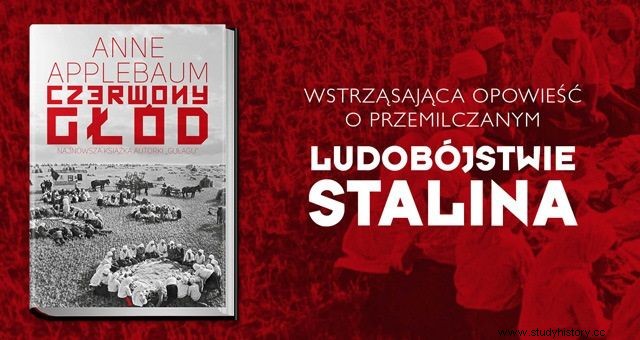"Cursed rise of the people of the earth!" - the left-wing idealists encouraged even in the nineteenth century. They probably did not expect the values they fought for to be so distorted and discredited in the next century. And they will take the lives of tens of millions of people.
5. The Great Purge:Dictator Lists Elites
Each - without exception - political system requires, from time to time, a replacement of the elite. The state apparatus wears out and becomes sluggish. Its correction is aimed at streamlining and modernizing the functioning of the state. Most often, this process takes place through a simple generational change. In democratic systems, citizens also have the option of leaving or ejecting a given officer.
In the USSR, where all decisions were made by Joseph Stalin, the "replacement" of officials was completely different. When the communist leader decided it was time to get rid of the state elite, he didn't stick around. Following the principle of a revolution devouring its children, slaughtered all inconvenient officers. And he replaced those who still remembered the times of Lenin and Trotsky with a new generation, blindly devoted to their leader.
The Great Purge is considered a mass elimination of intelligence. Those arrested under torture were brought to such a state that they admitted even the most absurd guilt. Not only apparatchiks ended their careers with a bullet in their heads. This way also generals, ordinary functionaries, comintern activists, and even doctors, intellectuals, scientists and artists died.
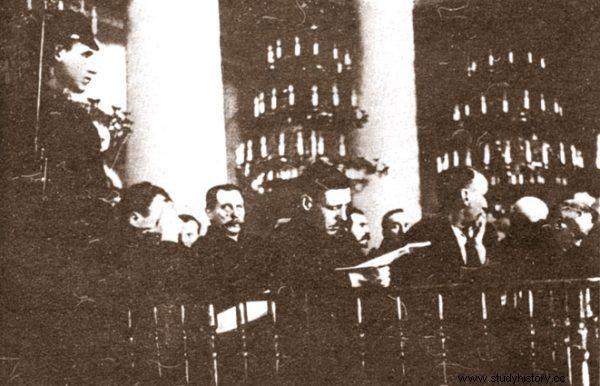
The dock of defendants during the second Moscow trial.
How big was the Great Purge? The numbers don't lie. In the years 1937-1938, under a special sentence of the NKVD, almost 700,000 citizens of the Soviet Union were executed . And Stalin gained a new, enthusiastic elite who blindly believed that the fate of his predecessors would not apply to her.
4. Holodomor - was it only the result of mismanagement?
When writing about the famines in Ukraine, some people only casually mention "the mistakes of the Soviet economic policy." They blame the restrictive collectivization and requisitioning of crops that unexpectedly led to the tragedy. Nonsense! Both of these factors were only tools for the implementation of Moscow's criminal policy.
The goal of the communists was to exterminate the inhabitants of Ukraine, including, above all, the "ideologically insecure" Ukrainian peasantry. This plan was implemented by them immediately after taking power. This is how their attitude is described by Anne Applebaum in the book "Red Hunger" :
When the Red Army entered the Donsk Oblast in January 1919, the Bolshevik leaders issued orders to solve the Cossack problem once and for all . The soldiers were ordered to "use mass terror against rich Cossacks and wipe them out completely ”.
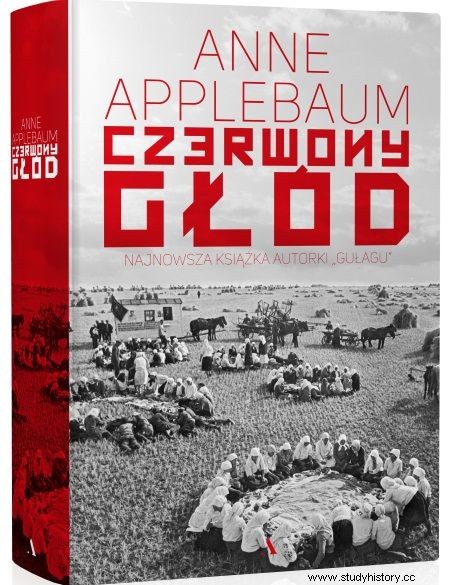
Anne Applebaum's newest book, Red Hunger, published in Poland by Agora, tells the story of the great famine in Ukraine, considered to be Stalinist genocide.
More than a decade after the events of the first post-war years, in 1932-33, people were brought to hunger for the second time. This time the size of the defeat was monstrous. Entire villages and towns were dying, and the urban population suffered. For the theft of a few state grains, people were punished with death or a ten-year stay in a prison camp. Effect? About 6 million fatalities. Towns and villages were full of human and animal skeletons. Those who survived saved themselves in every possible way, as evidenced by the history quoted in the "Black Book of Communism":
Every night, nearly 250 bodies of people who died of starvation or typhus are cleaned in Kharkiv. Many of them have been found to have no liver, which was probably pulled out through a wide incision. Police eventually caught a few mysterious "surgeons" who testified that the meat was used to stuff into dumplings that were then sold at the market.
3. From Stalin to Mao. So from the rain into the gutter
When browsing through the biographies of some post-war left-wing intellectuals, what is surprising above all is their endless naivety. When Khrushchev in 1956 informed the world about the crimes of Stalin, some of them took offense at the recent idol and replaced him with a new Chinese one. Probably not aware that the new favorite will outbid the Soviet tyrant.
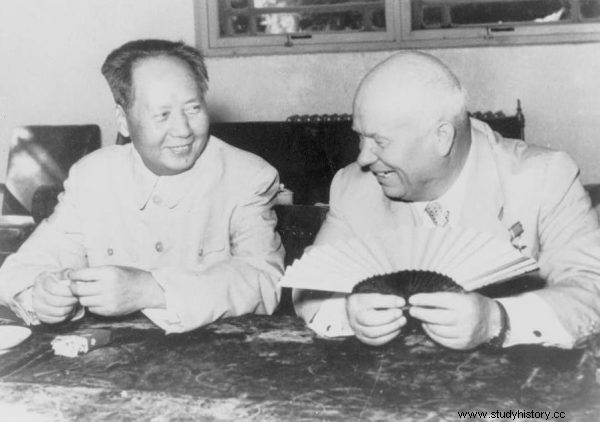
Mao and Khrushchev during the stay of the USSR leader in Beijing.
Even the most cautious and conservative researchers admit that the "made in China" version of communism caused a minimum of 65 million victims. It is worth adding that even in the 1920s, Chinese communists practiced future crimes by eliminating landowners. They dismembered their bodies and then roasted or fried them. Such practices are mentioned in the "Black Book of Communism":
Everyone was invited to a feast where the liver or heart of the former owner was shared between them, and attended rallies - the speaker stood in front of a crowd of people holding spades with freshly stuck in them decapitated heads.
Not surprisingly, Mao Zedong and his associates had little scruples after their conquest of power in China. They acted extremely ruthlessly. The tragic land reform and the catastrophic reorganization of the state under the name of the Great Leap Forward resulted in a famine with millions of victims. Another million "redundant" units were simply liquidated by the new government.

The big leap forward doctrine pushed by Mao Zedong turned out to be a death sentence for tens of millions of Chinese.
The world began to open its eyes to the true picture of Chinese communism only in the 1960s. information about the great purges, started in 1966 under the banner of the Great Proletarian Cultural Revolution, spread to the West . The number of victims of "cultural" changes is difficult to quantify. It is estimated that between 400,000 and a million citizens died then.
2. GULag - the only escape from the death penalty
Although death sentences were handed down lightly under Stalinism, it could have been avoided. The alternative, however, was not much better. It was a forced labor camp, one of the "islands" located in the infamous "Gulag archipelago". The system of labor camps was established in the times of Lenin. Under Stalin, in the mid-1930s, the number of prisoners grew to one million. Five years later, there were twice as many.
The communists quickly realized that they could easily gain free labor on the basis of the GULag. After all, anyone could be a subversive, reactionary and kulak. "In some regions, local leaders fought for more slave laborers to expand their industrial projects," writes in "Red Hunger" Anne Applebaum. And adds:
It is possible that officials in the Urals wanted to increase the number of kulaks precisely because they needed more workers in local mines and steel mills to meet the impossible requirements of the five-year plan.
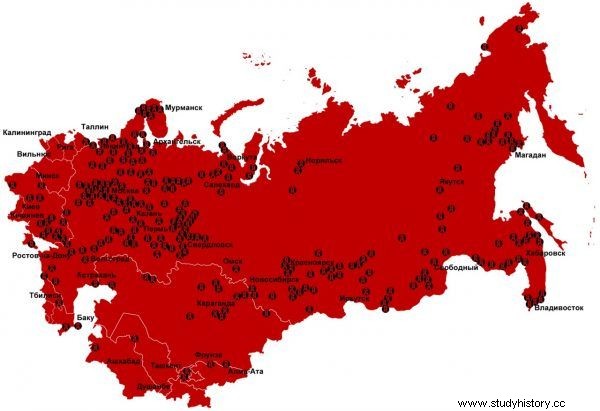
Map of the GULag camps in 1923-1961.
The prisoners in the labor camps were stripped of all dignity. Backbreaking work and inhuman conditions were very often the cause of death. There were also suicides. Surprisingly, however, there were those for whom even the GULag seemed like a godsend . These are the ones who previously survived the famine. In the already cited book "Red Hunger" Anne Applebaum quotes this excerpt from the memoirs of one of the convicts:
Years later, Zuzanna Pechora, a later Gulag prisoner, recalled a peasant co-inmate. Receiving her meager daily allowance, the woman sighed and stroked the small, stale slice: "Bread," she cooed. - That they give you to us every day too! ”.
1. Cambodia:Express Genocide
“A million good revolutionaries are enough for the country we are building. We do not need the rest. We'd rather kill ten friends than leave one enemy alive! " - the Cambodian communists declared. And, as it turned out, they took their words quite seriously.
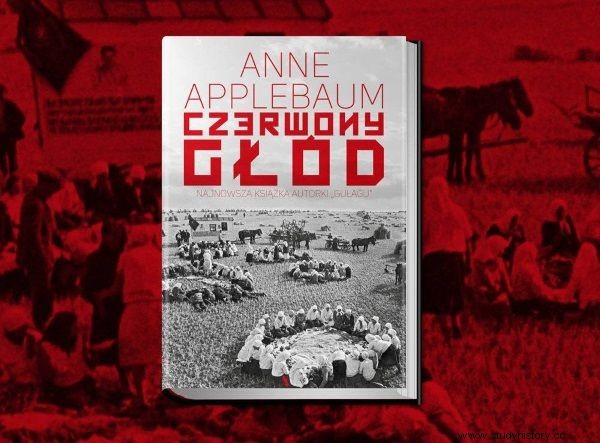
You can buy "Red Hunger" by Anne Applebaum at a discount in the empik.com bookstore.
As a result of the rule of the Khmer Rouge, in less than four years, between 1975 and 1979, more than two million people lost their lives, or every fourth inhabitant of the country! And although Chinese tyranny has far more lives on its conscience, the Cambodian version of communism is considered the most extreme type of totalitarianism in the twentieth century .
What is especially terrifying is their absolute contempt for the individual. The formation of a new human adapted to life under communism was extremely brutal. Interpersonal relations were systematically destroyed. There were also radical attempts to rid a person of any desires and needs. To achieve this, he was usually deprived of everything that was most valuable to him.
The changes that the brutal reforms of the communists had brought about in the mentality of the people of Cambodia were unimaginable. They are reported by one of the heroes of the book "Pol Pot. The Killing Fields ”.

The skulls of the victims of the bloody Khmer Rouge rule.
This is a student who returned to the country just a few months after the revolution. He says:
What I saw was beyond my imagination. The people (…) at the airport did not look like human beings. You might think they were items, vending machines from another planet . They belonged to an indefinable race, nondescript, phantoms clothed in darkness from some very distant planet.
Pol Pot was responsible for this hell. Before becoming one of the greatest criminals of the twentieth century, he studied in Paris. It was there that he immersed himself in the milieu of young French Marxists. They left a significant mark on the worldview of the Asian student.
Who knows - maybe it is some remorse of the communizing Western elite that makes the world know too little about the crimes of communism?
Buy the book at a discount on empik.com
